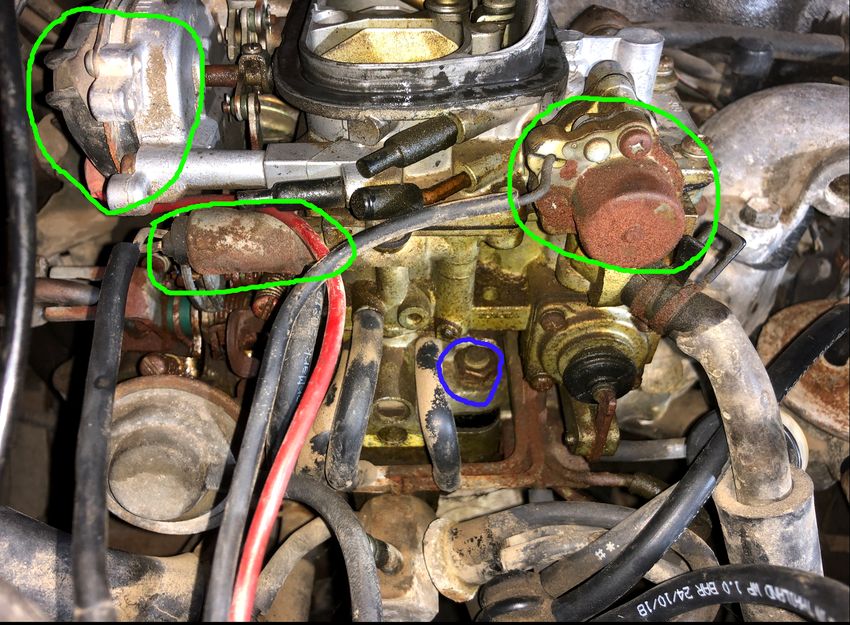The 1986 Toyota Pickup carburetor adjustment involves setting the idle and mixture screws according to a specific diagram. Owners need these schematics for accurate tuning and performance enhancement.
To properly adjust a 1986 Toyota Pickup’s carburetor, enthusiasts turn to detailed diagrams that outline the location and setting of the idle and mixture screws. These diagrams, often found in the truck’s service manual or enthusiast forums, provide the crucial visual guidance necessary for tuning the carburetor to optimal function.
For vintage vehicle fans, maintaining a 1986 Toyota Pickup means ensuring the carburetor functions efficiently. Over time, a carburetor may require adjustments to compensate for wear and changes in engine performance. Proper tuning can also address issues with fuel economy and engine stability, making it essential for owners to understand the adjustment process. An accurate adjustment diagram is a valuable resource, contributing to improved engine response and longevity. With a focus on precision and attention to detail, truck enthusiasts leverage these diagrams to maintain their Toyota Pickup in peak condition.

Credit: www.lceperformance.com
Introduction To The 1986 Toyota Pickup Carburetor
For truck enthusiasts and DIY mechanics, the 1986 Toyota Pickup remains a beloved classic. At the heart of its dependable performance is the carburetor. Understanding its mechanics can keep your Toyota in peak shape. The carburetor manages fuel and air mix, vital for clean and efficient engine operation.
Overview Of The Carburetor’s Role In Engine Function
The carburetor is key for your Toyota’s engine. It blends air and fuel for internal combustion. A good mix means better fuel economy and power. Let’s dive into how this vital component works.
- Quality of mixture: Perfect air-fuel mix boosts engine performance.
- Engine speed and power: The carburetor adjusts mixtures for different speeds.
- Throttle response: It controls the speed at which your truck responds to input.
Identifying Your 1986 Toyota Pickup’s Carburetor Model
Knowing your carburetor model is essential. It helps you find the right adjustment diagrams. For the 1986 model, the 22R series engine is common, often paired with the Aisin carburetor.
- Locate your carburetor and note any model numbers.
- Check for identifying marks or labels on the carburetor’s body.
- Compare your findings with a parts catalog for accuracy.

Credit: www.ebay.com
Preparing For Carburetor Adjustment
Adjusting the carburetor of your 1986 Toyota Pickup is key for optimal performance. Before you begin, ensure you gather the correct tools and know the safety protocols. Follow this guide for a smooth adjustment process.
Tools And Equipment Needed For Adjustment
Gathering the right tools is the first step to a successful carburetor adjustment. Here’s what you’ll need:
- Screwdrivers
- Tachometer
- Wrench set
- Carburetor cleaner
With these tools at hand, you’re ready to tackle the task ahead.
Safety Precautions And Initial Setup
Safety always comes first. Remember these tips:
- Work in a well-ventilated area.
- Keep a fire extinguisher nearby.
- Disconnect the battery before starting.
For the initial setup, make sure the engine is cool. Check the vacuum lines for any signs of wear or damage. Replace if necessary to avoid incorrect readings. Refer to the carburetor adjustment diagram for your specific model before proceeding. This ensures accuracy in the adjustment process.
Understanding The Carburetor Adjustment Diagram
The carburetor is a critical component in your 1986 Toyota Pickup, controlling the mixture of air and fuel that powers the engine. An adjustment diagram is a roadmap to proper carburetion; it ensures the engine runs smoothly. This guide will walk you through understanding and using the carburetor adjustment diagram to keep your Toyota Pickup in top condition.
Reading The Carburetor Diagram: A Step-by-step Guide
Follow this guide to navigate the carburetor diagram:
- Locate the diagram: Your Toyota’s service manual contains the carburetor adjustment diagram.
- Review the legend: Legends detail what each symbol and line represent, from hoses to screws.
- Trace the airflow: Start at the air filter and move through the diagram to the engine.
- Identify adjustments: Look for labeled adjustment points, where you can tweak the fuel-air mixture.
Identifying Key Components: Idle Screw, Vacuum Hose, And Electric Choke
The main components you need to know are:
- Idle Screw – This regulates the engine’s idle speed. Find it marked on the diagram as a flat or Phillips head screw.
- Vacuum Hose – These are the lines on the diagram. They manage air pressure and flow within the carburetor system.
- Electric Choke – This component helps to start the engine when cold. It’s usually shown as a round symbol near the top of the carburetor.
Remember: Bolding indicates the most vital parts. With these guidelines and a proper diagram, adjustments are a breeze. Keep these pointers in mind while tuning your 1986 Toyota Pickup carburetor for better performance and longevity.
Idle Speed And Mixture Adjustments
Getting the idle speed and mixture right is crucial for your 1986 Toyota Pickup’s performance. These adjustments ensure a smooth ride and optimal fuel economy. We’ll guide you through each step with precision.
Adjusting The Idle Speed Screw For Optimal Performance
The idle speed screw controls your engine’s idle speed. A correct idle speed prevents stalling and maintains the engine’s health. Follow these steps for a perfect setting:
- Warm up the engine.
- Locate the idle speed screw on the carburetor.
- Turn the screw slowly to reach the recommended RPM.
- Use a tachometer to measure engine RPMs.
- After adjustments, let the engine idle to confirm stability.
Fine-tuning The Fuel Mixture: A Detailed Procedure
A well-adjusted fuel mixture supports engine efficiency and longevity. Stick to these steps for the best fuel mixture:
- Find the fuel mixture screws on your carburetor.
- Turn the screws inward for a leaner mixture or outward for a richer mixture.
- Adjust each screw equally to maintain balance.
- Seek the highest, stable idle RPM with the screws.
- After reaching the sweet spot, tighten the screws slightly.
Vacuum Systems And Their Impact On Carburetion
The heart of the 1986 Toyota Pickup’s performance lies in proper carburetion, which relies heavily on the vacuum system. This system ensures the engine gets the right air-fuel mixture by regulating airflow. When vacuum hoses are routed correctly and connections are secure, the engine runs smoothly. A faulty vacuum system can lead to engine stalling, poor gas mileage, and inadequate engine performance. Understanding and maintaining these vacuum systems is pivotal to ensuring your classic Toyota Pickup runs like a dream.
Vacuum Hose Routing And Connection
The carburetor and engine interact through a network of vacuum hoses. Correct routing is essential for engine efficiency. Over time, hoses can become brittle and crack, leading to vacuum leaks. Here’s a step-by-step guide to ensure proper connection:
- Refer to the carburetor adjustment diagram for your vehicle’s specific vacuum hose layout.
- Inspect all hoses for cracks, wear, and tear.
- Replace damaged hoses with ones that match the size and length.
- Secure the hoses tightly to both the carburetor and engine ports.
- Check for proper seal to prevent leaks.
Diagnosing And Fixing Vacuum Leaks For Better Carburetor Performance
Vacuum leaks can lead to engine misfires and poor performance. Follow these steps for diagnosing and fixing leaks:
- Listen for a hissing sound which may indicate a vacuum leak.
- Use a vacuum gauge to check the system’s pressure.
- Apply soapy water to vacuum lines; bubbling indicates a leak.
- If a leak is found, replace the affected hose.
- Adjust the carburetor settings to ensure the engine runs smoothly after repairs.

Credit: bitdrivencircuits.com
Testing And Finalizing The Tuning Process
Once you’ve adjusted the carburetor on your 1986 Toyota Pickup, it’s time to test. Testing ensures everything runs smoothly. Let’s look at how to perform these tests effectively.
Performing Idle And Load Tests After Adjustments
Idle and load tests check a carburetor’s performance. These steps guide you through both:
- Start the engine and let it warm up to normal operating temperature.
- Set the idle speed screw to achieve the correct RPM.
- Check the idle quality. The engine should run smoothly without stalling.
- Perform a load test. Drive your truck or apply a load if stationary.
- Observe how the engine functions under load. It should not hesitate or stall.
If the engine hesitates or the idle isn’t steady, further adjustments might be needed. Remember to adjust in small increments.
Tips For Maintaining Carburetor Health Post-adjustment
Maintaining your carburetor extends its life and efficiency. Follow these tips:
- Clean your carburetor regularly to prevent build-up.
- Use fresh, high-quality fuel for the best performance.
- Check air filters. Clean or replace them as needed.
- Inspect hoses and connections for leaks or wear.
- Keep an eye on the carburetor settings and adjust when necessary.
Following these simple steps can prevent future issues. Your 1986 Toyota Pickup’s engine will thank you!
Frequently Asked Questions Of 1986 Toyota Pickup Carburetor Adjustment Diagram
How Do You Adjust The Idle On A Carburetor?
Locate the idle adjustment screw on the carburetor. Turn the screw clockwise to increase idle speed, counterclockwise to decrease it. Achieve desired RPM as per the manufacturer’s specifications. Always consult the vehicle’s manual for specific adjustments and optimal settings.
What Is The Engine Specs Of The Toyota 22r?
The Toyota 22R engine features a 2. 4L inline 4-cylinder layout, producing up to 105 horsepower and 137 lb-ft of torque.
How Do You Adjust The Idle On A Solex?
To adjust the idle on a Solex carburetor, locate the idle screw. Turn it clockwise to increase or counterclockwise to decrease the idle speed. Ensure the engine runs smoothly at the desired RPM.
How Do You Lean Out A Weber Carburetor?
To lean out a Weber carburetor, locate the mixture screws and turn them clockwise, monitoring engine performance. Adjust until the engine runs smoothly without stumbling for optimal leanness.
Conclusion
Tinkering with your 1986 Toyota Pickup’s carburetor can be transformative for vehicle performance. This post’s guidelines should make the task less daunting. Remember, precision is key for optimal engine function. Regular maintenance after adjustments will ensure continued efficiency. Drive safely, and enjoy a smoother ride in your classic Toyota.





